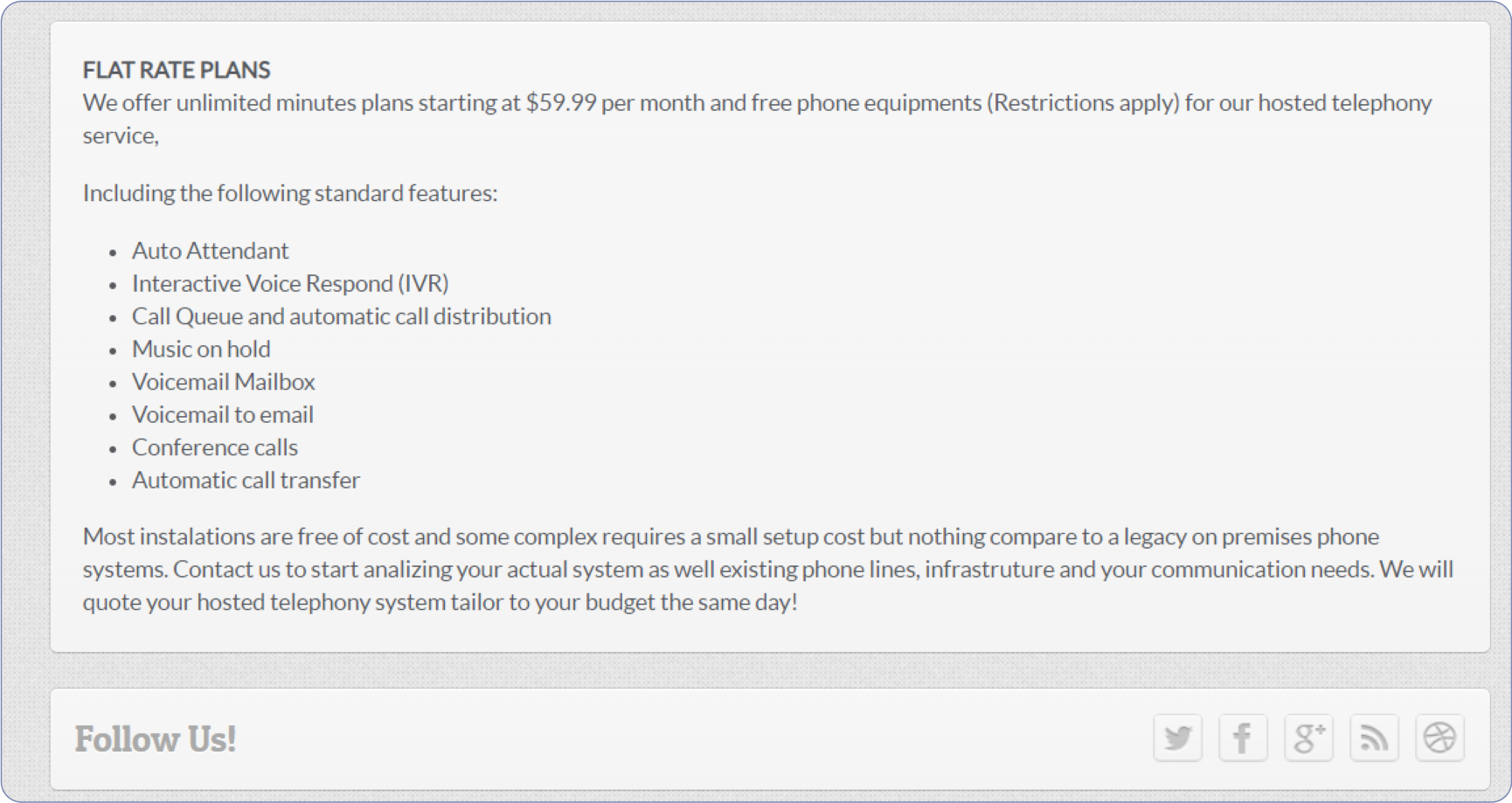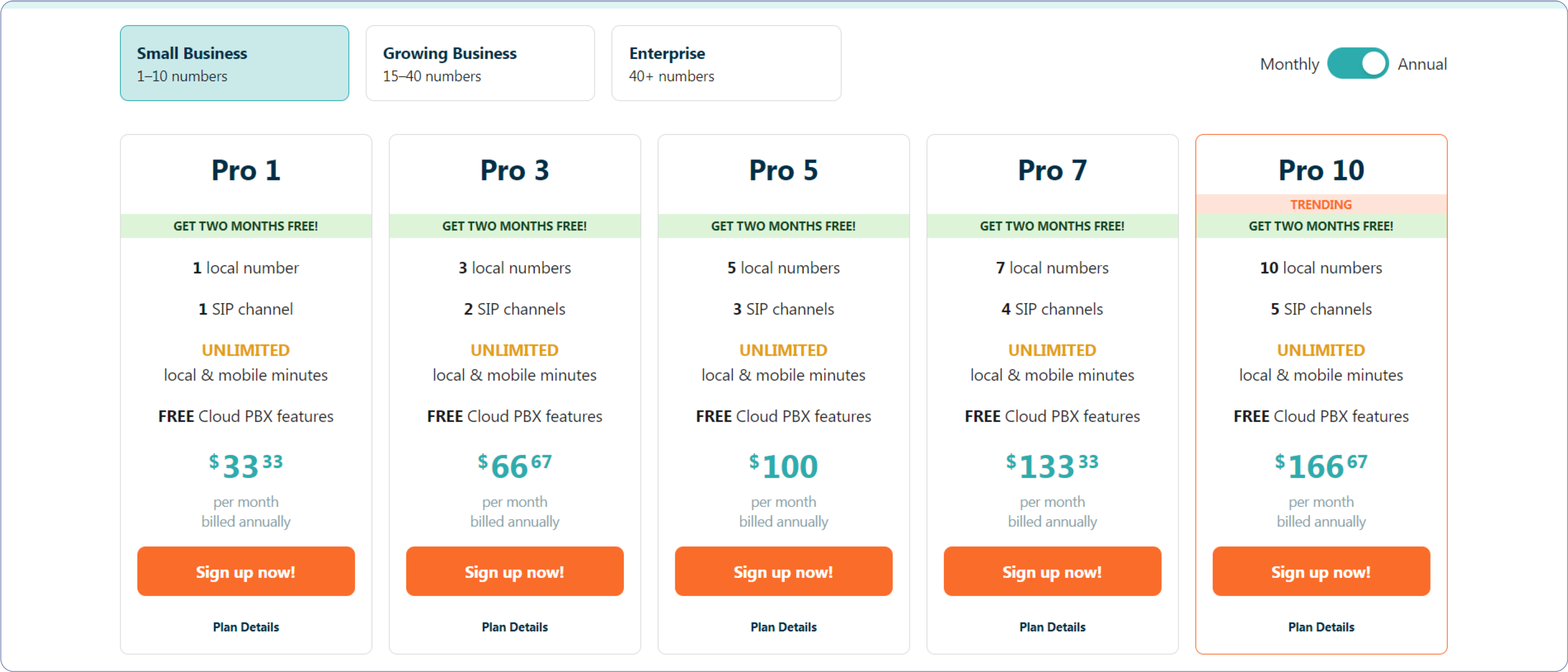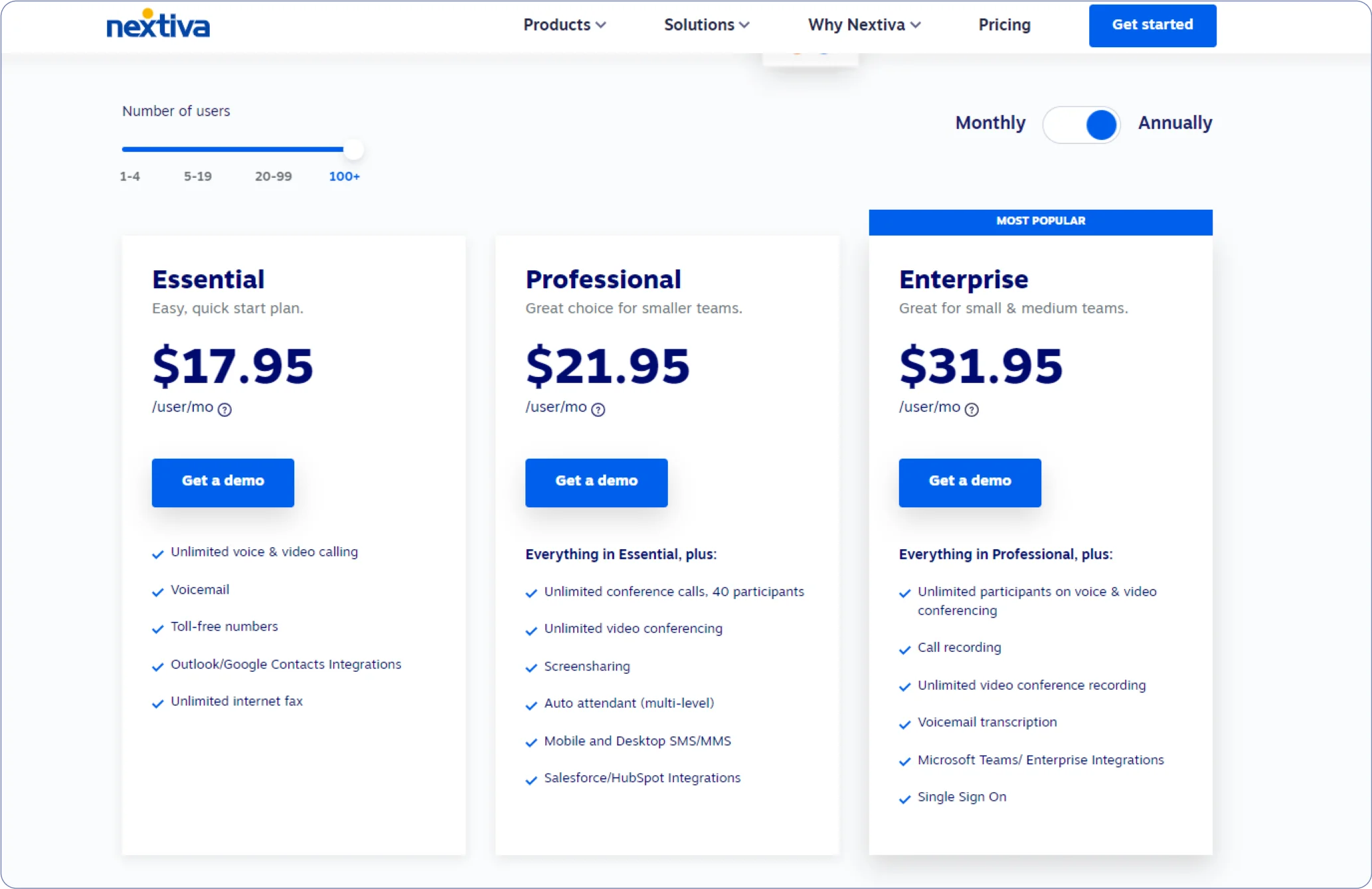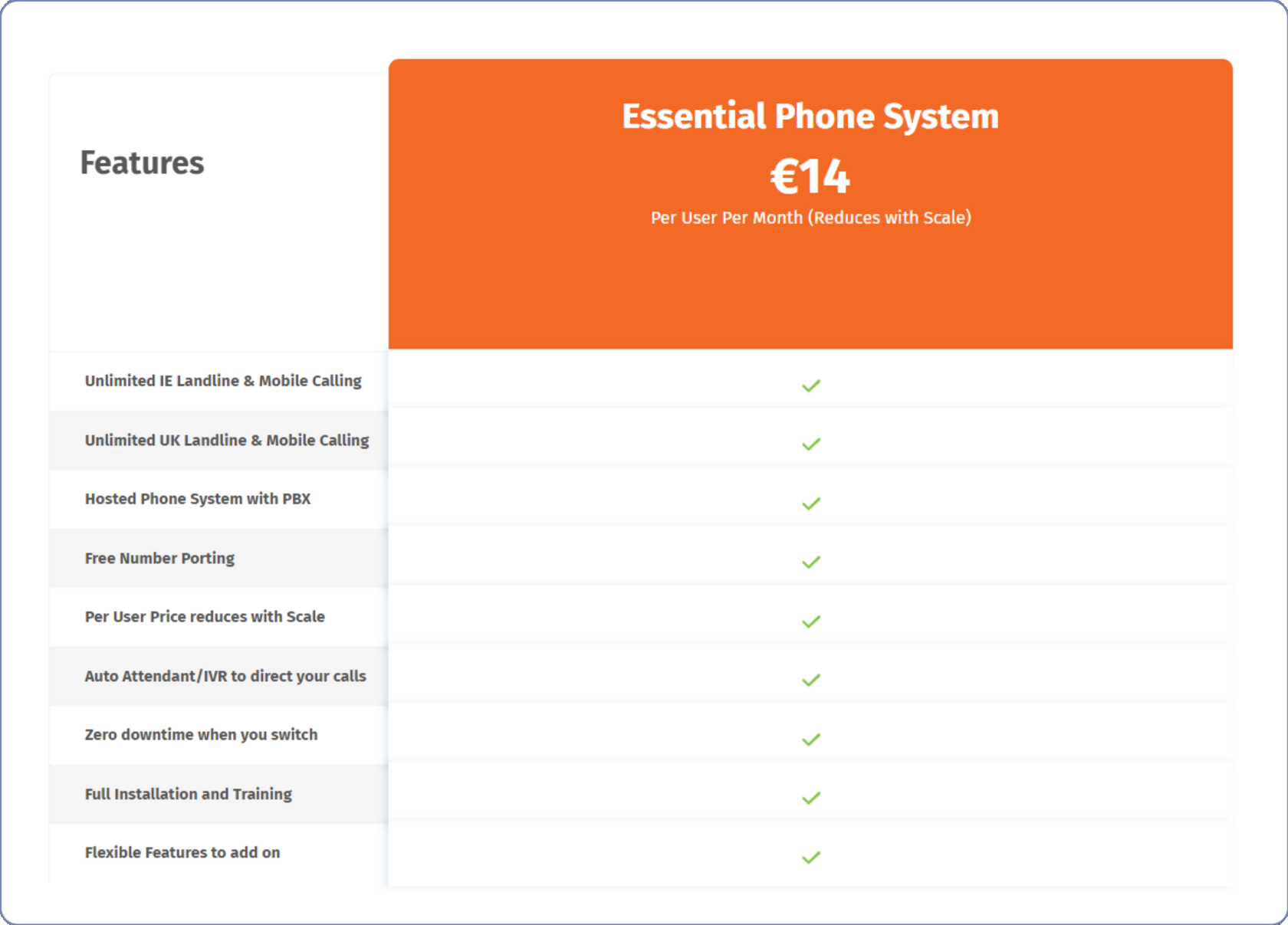
There are many different Cloud PBX pricing models to choose from when designing your Cloud PBX service. Some companies offer one package for all clients, while others offer multiple packages with various features and capabilities. Let's discuss the pros and cons of these models to help you decide what's most suitable for selling a Cloud based PBX solution.
Some telecom operators offer a free Cloud PBX with a few features to try. As usual, such operators primarily sell telephony and provide a free service as an additional advantage to stand out. If clients need a more robust Cloud PBX system, they purchase advanced features.
3CX offers a free phone system with limited features, but the company also has other pricing plans for different B2B buyer personas. In this case, new clients can try a service for free and then upgrade their plan, which is a common strategy among Cloud PBX providers.

The freemium model is best for companies that don't sell Cloud PBX as a main service. If you aim to be a professional Cloud PBX provider, you should focus on other models.

This model offers one pricing plan for all subscribers. You can create a single package with all possible features, making the prospect's only decision whether to purchase your plan or choose another provider. This model offers a very clear Cloud PBX cost.
A company might set a single price, like $59.99, for all standard features, including call transfer, voicemails, and IVR, with no add-ons.

Flat-rate pricing can be suitable for companies aiming to test an MVP because there’s no need to analyze competitors thoroughly and create different buyer personas. In other cases, it will be hard to attract a lot of subscribers and scale the Cloud PBX service with only one package. To offer a professional service, you should focus on models with different pricing plans.

This model involves creating multiple packages or calculating bills based on used storage, features, or other measurable points. The more a customer uses the Cloud PBX service, the more they pay.
SIPcity, a VoIP provider, specified many packages with only differences in the number of local numbers and SIP channels. Customers will see all packages and find out the approximate number of numbers and SIP channels that best suit them. Free Cloud PBX features are also included in every plan.

As a rule, usage-based pricing suits companies that sell other telecom services primarily and want to retain existing subscribers. For telecom operators that want to make a Cloud PBX service a main, it will be harder to attract new customers because the positioning based on only usage isn’t clear for end customers. Focusing on sought-after features and forming plans based on competitive advantages is much better.


In this case, companies form a few packages with additional parameters, letting users find their best fit. Most Cloud PBX providers offer three or four pricing plans targeting different B2B buyer personas, from Cloud PBX for small business to enterprise.
Nextiva offers Essential, Professional, and Enterprise plans. Each further package has all the features of the previous one and adds new features. Moreover, potential customers can choose the number of users and combine it with plans — as a result, they get a unique pricing package designed for specific needs.

Though tiered pricing requires thorough market analysis and complicated implementation, it will scale the service and increase revenue. As for the number of packages, it’s better to create three or four plans and highlight the most popular. If you form fewer, it will be harder to attract new buyer personas, and if you create more, various packages can confuse users.
Besides, you can offer an annual billing with a significant discount, which benefits both sides. This approach can help you get upfront resources and survive a financial crisis (as it was during the COVID-19 pandemic).

This model means customers pay a fixed price per employee. You can set one price per user or form packages that scale with the number of users.
A VoIP provider might offer an "Essential Phone System" at €14 per user per month, with discounts for a higher number of users.

The problem with this model is the same as with the usage-based pricing. Instead of focusing on Cloud PBX advantages and competitive characteristics, this model highlights the secondary points that won’t attract customers effectively.

Here, companies offer a basic package with minimal features and sell other features as add-ons. They set different Cloud PBX pricing for each distinct feature.
In this case, companies may have a basic package with a minimal set of features and offer add-ons or sell completely distinct features. They specify different pricing for each feature and sell them separately.
OnSIP provides a basic phone system package with essential functionality and offers the option to purchase separate features such as auto attendant, enhanced music on hold, call recording, etc. Customers can customize their plans with such possibilities.

Offering features out of packages is good only when you have experienced sales reps who understand a cloud PBX service perfectly. As a rule, companies choose this model if they have knowledgeable product experts ready to train their staff regularly. Otherwise, it’s much better to form packages with sought-after features — this will help your reps get a positive sales experience without deep expertise.





For most cloud PBX providers, tiered pricing often strikes the right balance. It’s not as complex for customers as per-feature pricing and allows you to target different B2B buyer personas effectively.
Other models can be less than ideal due to high client maintenance costs, weak sales motivation, or unclear package conditions. The final decision on your cloud pbx pricing will depend on the clients you want to target, so analyze these models carefully to decide what’s best for your cloud PBX service.

There are many different Cloud PBX pricing models to choose from when designing your Cloud PBX service. Some companies offer one package for all clients, while others offer multiple packages with various features and capabilities. Let's discuss the pros and cons of these models to help you decide what's most suitable for selling a Cloud based PBX solution.
Some telecom operators offer a free Cloud PBX with a few features to try. As usual, such operators primarily sell telephony and provide a free service as an additional advantage to stand out. If clients need a more robust Cloud PBX system, they purchase advanced features.
3CX offers a free phone system with limited features, but the company also has other pricing plans for different B2B buyer personas. In this case, new clients can try a service for free and then upgrade their plan, which is a common strategy among Cloud PBX providers.

The freemium model is best for companies that don't sell Cloud PBX as a main service. If you aim to be a professional Cloud PBX provider, you should focus on other models.

This model offers one pricing plan for all subscribers. You can create a single package with all possible features, making the prospect's only decision whether to purchase your plan or choose another provider. This model offers a very clear Cloud PBX cost.
A company might set a single price, like $59.99, for all standard features, including call transfer, voicemails, and IVR, with no add-ons.

Flat-rate pricing can be suitable for companies aiming to test an MVP because there’s no need to analyze competitors thoroughly and create different buyer personas. In other cases, it will be hard to attract a lot of subscribers and scale the Cloud PBX service with only one package. To offer a professional service, you should focus on models with different pricing plans.

This model involves creating multiple packages or calculating bills based on used storage, features, or other measurable points. The more a customer uses the Cloud PBX service, the more they pay.
SIPcity, a VoIP provider, specified many packages with only differences in the number of local numbers and SIP channels. Customers will see all packages and find out the approximate number of numbers and SIP channels that best suit them. Free Cloud PBX features are also included in every plan.

As a rule, usage-based pricing suits companies that sell other telecom services primarily and want to retain existing subscribers. For telecom operators that want to make a Cloud PBX service a main, it will be harder to attract new customers because the positioning based on only usage isn’t clear for end customers. Focusing on sought-after features and forming plans based on competitive advantages is much better.


In this case, companies form a few packages with additional parameters, letting users find their best fit. Most Cloud PBX providers offer three or four pricing plans targeting different B2B buyer personas, from Cloud PBX for small business to enterprise.
Nextiva offers Essential, Professional, and Enterprise plans. Each further package has all the features of the previous one and adds new features. Moreover, potential customers can choose the number of users and combine it with plans — as a result, they get a unique pricing package designed for specific needs.

Though tiered pricing requires thorough market analysis and complicated implementation, it will scale the service and increase revenue. As for the number of packages, it’s better to create three or four plans and highlight the most popular. If you form fewer, it will be harder to attract new buyer personas, and if you create more, various packages can confuse users.
Besides, you can offer an annual billing with a significant discount, which benefits both sides. This approach can help you get upfront resources and survive a financial crisis (as it was during the COVID-19 pandemic).

This model means customers pay a fixed price per employee. You can set one price per user or form packages that scale with the number of users.
A VoIP provider might offer an "Essential Phone System" at €14 per user per month, with discounts for a higher number of users.

The problem with this model is the same as with the usage-based pricing. Instead of focusing on Cloud PBX advantages and competitive characteristics, this model highlights the secondary points that won’t attract customers effectively.

Here, companies offer a basic package with minimal features and sell other features as add-ons. They set different Cloud PBX pricing for each distinct feature.
In this case, companies may have a basic package with a minimal set of features and offer add-ons or sell completely distinct features. They specify different pricing for each feature and sell them separately.
OnSIP provides a basic phone system package with essential functionality and offers the option to purchase separate features such as auto attendant, enhanced music on hold, call recording, etc. Customers can customize their plans with such possibilities.

Offering features out of packages is good only when you have experienced sales reps who understand a cloud PBX service perfectly. As a rule, companies choose this model if they have knowledgeable product experts ready to train their staff regularly. Otherwise, it’s much better to form packages with sought-after features — this will help your reps get a positive sales experience without deep expertise.





For most cloud PBX providers, tiered pricing often strikes the right balance. It’s not as complex for customers as per-feature pricing and allows you to target different B2B buyer personas effectively.
Other models can be less than ideal due to high client maintenance costs, weak sales motivation, or unclear package conditions. The final decision on your cloud pbx pricing will depend on the clients you want to target, so analyze these models carefully to decide what’s best for your cloud PBX service.

There are many different Cloud PBX pricing models to choose from when designing your Cloud PBX service. Some companies offer one package for all clients, while others offer multiple packages with various features and capabilities. Let's discuss the pros and cons of these models to help you decide what's most suitable for selling a Cloud based PBX solution.
Some telecom operators offer a free Cloud PBX with a few features to try. As usual, such operators primarily sell telephony and provide a free service as an additional advantage to stand out. If clients need a more robust Cloud PBX system, they purchase advanced features.
3CX offers a free phone system with limited features, but the company also has other pricing plans for different B2B buyer personas. In this case, new clients can try a service for free and then upgrade their plan, which is a common strategy among Cloud PBX providers.

The freemium model is best for companies that don't sell Cloud PBX as a main service. If you aim to be a professional Cloud PBX provider, you should focus on other models.


This model offers one pricing plan for all subscribers. You can create a single package with all possible features, making the prospect's only decision whether to purchase your plan or choose another provider. This model offers a very clear Cloud PBX cost.
A company might set a single price, like $59.99, for all standard features, including call transfer, voicemails, and IVR, with no add-ons.

Flat-rate pricing can be suitable for companies aiming to test an MVP because there’s no need to analyze competitors thoroughly and create different buyer personas. In other cases, it will be hard to attract a lot of subscribers and scale the Cloud PBX service with only one package. To offer a professional service, you should focus on models with different pricing plans.

This model involves creating multiple packages or calculating bills based on used storage, features, or other measurable points. The more a customer uses the Cloud PBX service, the more they pay.
SIPcity, a VoIP provider, specified many packages with only differences in the number of local numbers and SIP channels. Customers will see all packages and find out the approximate number of numbers and SIP channels that best suit them. Free Cloud PBX features are also included in every plan.

As a rule, usage-based pricing suits companies that sell other telecom services primarily and want to retain existing subscribers. For telecom operators that want to make a Cloud PBX service a main, it will be harder to attract new customers because the positioning based on only usage isn’t clear for end customers. Focusing on sought-after features and forming plans based on competitive advantages is much better.


In this case, companies form a few packages with additional parameters, letting users find their best fit. Most Cloud PBX providers offer three or four pricing plans targeting different B2B buyer personas, from Cloud PBX for small business to enterprise.
Nextiva offers Essential, Professional, and Enterprise plans. Each further package has all the features of the previous one and adds new features. Moreover, potential customers can choose the number of users and combine it with plans — as a result, they get a unique pricing package designed for specific needs.

Though tiered pricing requires thorough market analysis and complicated implementation, it will scale the service and increase revenue. As for the number of packages, it’s better to create three or four plans and highlight the most popular. If you form fewer, it will be harder to attract new buyer personas, and if you create more, various packages can confuse users.
Besides, you can offer an annual billing with a significant discount, which benefits both sides. This approach can help you get upfront resources and survive a financial crisis (as it was during the COVID-19 pandemic).

This model means customers pay a fixed price per employee. You can set one price per user or form packages that scale with the number of users.
A VoIP provider might offer an "Essential Phone System" at €14 per user per month, with discounts for a higher number of users.

The problem with this model is the same as with the usage-based pricing. Instead of focusing on Cloud PBX advantages and competitive characteristics, this model highlights the secondary points that won’t attract customers effectively.


Here, companies offer a basic package with minimal features and sell other features as add-ons. They set different Cloud PBX pricing for each distinct feature.
In this case, companies may have a basic package with a minimal set of features and offer add-ons or sell completely distinct features. They specify different pricing for each feature and sell them separately.
OnSIP provides a basic phone system package with essential functionality and offers the option to purchase separate features such as auto attendant, enhanced music on hold, call recording, etc. Customers can customize their plans with such possibilities.

Offering features out of packages is good only when you have experienced sales reps who understand a cloud PBX service perfectly. As a rule, companies choose this model if they have knowledgeable product experts ready to train their staff regularly. Otherwise, it’s much better to form packages with sought-after features — this will help your reps get a positive sales experience without deep expertise.



For most cloud PBX providers, tiered pricing often strikes the right balance. It’s not as complex for customers as per-feature pricing and allows you to target different B2B buyer personas effectively.
Other models can be less than ideal due to high client maintenance costs, weak sales motivation, or unclear package conditions. The final decision on your cloud pbx pricing will depend on the clients you want to target, so analyze these models carefully to decide what’s best for your cloud PBX service.
Join our newsletter: simple, useful updates on telecom and Cloud PBX

Join Our Newsletter: Simple, Useful Updates on Telecom and Cloud PBX
